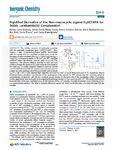Mostrar o rexistro simple do ítem
Rigidified Derivative of the Non-macrocyclic Ligand H₄OCTAPA for Stable Lanthanide(III) Complexation
| dc.contributor.author | Lucio Martínez, Fátima | |
| dc.contributor.author | Garda, Zoltán | |
| dc.contributor.author | Váradi, Balázs | |
| dc.contributor.author | Kálmán, Ferenc | |
| dc.contributor.author | Esteban-Gómez, David | |
| dc.contributor.author | Tóth, Éva | |
| dc.contributor.author | Tircsó, Gyula | |
| dc.contributor.author | Platas-Iglesias, Carlos | |
| dc.date.accessioned | 2022-06-30T10:14:55Z | |
| dc.date.available | 2022-06-30T10:14:55Z | |
| dc.date.issued | 2022-03-11 | |
| dc.identifier.citation | Lucio-Martínez, F.; Garda, Z.; Váradi, B.; Kálmán, F. K.; Esteban-Gómez, D.; Tóth, É.; Tircsó, G.; Platas-Iglesias, C. Rigidified Derivative of the Non-Macrocyclic Ligand H₄OCTAPA for Stable Lanthanide(III) Complexation. Inorg. Chem. 2022, 61 (12), 5157–5171. https://doi.org/10.1021/acs.inorgchem.2c00501. | es_ES |
| dc.identifier.issn | 0020-1669 | |
| dc.identifier.issn | 1520-510X | |
| dc.identifier.uri | http://hdl.handle.net/2183/31045 | |
| dc.description | Financiado para publicación en acceso aberto: Universidade da Coruña/CISUG | es_ES |
| dc.description.abstract | [Abstract] The stability constants of lanthanide complexes with the potentially octadentate ligand CHXOCTAPA4–, which contains a rigid 1,2-diaminocyclohexane scaffold functionalized with two acetate and two picolinate pendant arms, reveal the formation of stable complexes [log KLaL = 17.82(1) and log KYbL = 19.65(1)]. Luminescence studies on the Eu3+ and Tb3+ analogues evidenced rather high emission quantum yields of 3.4 and 11%, respectively. The emission lifetimes recorded in H2O and D2O solutions indicate the presence of a water molecule coordinated to the metal ion. 1H nuclear magnetic relaxation dispersion profiles and 17O NMR chemical shift and relaxation measurements point to a rather low water exchange rate of the coordinated water molecule (kex298 = 1.58 × 106 s–1) and relatively high relaxivities of 5.6 and 4.5 mM–1 s–1 at 20 MHz and 25 and 37 °C, respectively. Density functional theory calculations and analysis of the paramagnetic shifts induced by Yb3+ indicate that the complexes adopt an unprecedented cis geometry with the two picolinate groups situated on the same side of the coordination sphere. Dissociation kinetics experiments were conducted by investigating the exchange reactions of LuL occurring with Cu2+. The results confirmed the beneficial effect of the rigid cyclohexyl group on the inertness of the Lu3+ complex. Complex dissociation occurs following proton- and metal-assisted pathways. The latter is relatively efficient at neutral pH, thanks to the formation of a heterodinuclear hydroxo complex. | es_ES |
| dc.description.sponsorship | F.L.-M., D.E.-G., and C.P.-I. thank Ministerio de Ciencia e Innovación (Grant PID2019-104626GB-I00) and Xunta de Galicia (ED431B 2020/52) for generous financial support. The authors thank the financial support for the Hungarian National Research, Development and Innovation Office (NKFIH K-128201, 134694 and FK-134551 projects). G.T. and C.P.-I. gratefully acknowledge the bilateral Hungarian–Spanish Science and Technology Cooperation Program (2019-2.1.11-TET-2019-00084 supported by NKFIH). B.V. was supported by the Doctoral School of Chemistry at the University of Debrecen, Debrecen, Hungary. This publication and the scientific research were supported by the Gedeon Richter’s Talentum Foundation established by Gedeon Richter Plc (Gedeon Richter Ph.D. Fellowship). The research was prepared with the professional support of the Doctoral Student Scholarship Program of the Cooperative Doctoral Program of the Ministry of Innovation and Technology financed from the National Research, Development and Innovation Fund (NKFIH). The research was supported by the ÚNKP-21-4 new national excellence program of the Ministry of Human Capacities (F.K.K.) and the János Bolyai Research Scholarship of the Hungarian Academy of Sciences (F.K.K.). The authors are indebted to Centro de Supercomputación de Galicia (CESGA) for providing the computer facilities. C.P.-I. thanks Prof. M. Mazzanti for noticing that the emission quantum yields reported previously for OCTAPA4– complexes were incorrect. Funding for open access provided by Universidade da Coruña/CISUG | es_ES |
| dc.description.sponsorship | Xunta de Galicia; ED431B 2020/52 | es_ES |
| dc.description.sponsorship | Hungary. National Research, Development and Innovation Office; NKFIH K-128201 | es_ES |
| dc.description.sponsorship | Hungary. National Research, Development and Innovation Office; NKFIH K-134694 | es_ES |
| dc.description.sponsorship | Hungary. National Research, Development and Innovation Office; NKFIH FK-134551 | es_ES |
| dc.description.sponsorship | Hungary. National Research, Development and Innovation Office; 2019-2.1.11-TET-2019-00084 | es_ES |
| dc.description.sponsorship | Hungary. Ministry of Human Capacities; ÚNKP-21-4 | es_ES |
| dc.language.iso | eng | es_ES |
| dc.publisher | American Chemical Society | es_ES |
| dc.relation | info:eu-repo/grantAgreement/AEI/Plan Estatal de Investigación Científica y Técnica y de Innovación 2017-2020/PID2019-104626GB-I00/ES/PLATAFORMAS INNOVADORAS PARA APLICACIONES RADIOFARMACEUTICAS/ | |
| dc.relation.uri | https://doi.org/10.1021/acs.inorgchem.2c00501 | es_ES |
| dc.rights | Atribución 4.0 Internacional | es_ES |
| dc.rights.uri | http://creativecommons.org/licenses/by/4.0/ | * |
| dc.subject | Ions | |
| dc.subject | Ligands | |
| dc.subject | Metals | |
| dc.subject | Molecular structure | |
| dc.subject | Stability | |
| dc.title | Rigidified Derivative of the Non-macrocyclic Ligand H₄OCTAPA for Stable Lanthanide(III) Complexation | es_ES |
| dc.type | info:eu-repo/semantics/article | es_ES |
| dc.rights.access | info:eu-repo/semantics/openAccess | es_ES |
| UDC.journalTitle | Inorganic Chemistry | es_ES |
| UDC.volume | 61 | es_ES |
| UDC.issue | 12 | es_ES |
| UDC.startPage | 5157 | es_ES |
| UDC.endPage | 5171 | es_ES |
| dc.identifier.doi | 10.1021/acs.inorgchem.2c00501 |
Ficheiros no ítem
Este ítem aparece na(s) seguinte(s) colección(s)
-
GI-REACT! - Artigos [107]






